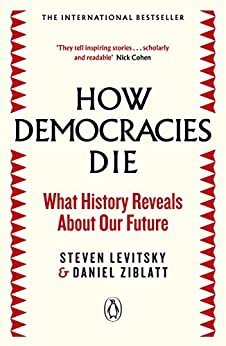Is Your Democracy Dead?
Book Review: How Democracies Die
Grab its wrist, check the pulse, is it dead? Or is it alive? Or is it dying, slowly, crumbling, piece by piece, unnoticed, your democracy!!

The modern world needs democracy, we all do. But are we well enough to know if it is really standing healthy or is it being attacked from inside out and is on the verge of death? The death of our democracy?
Daniel Ziblatt and Steven Levitsky, in their 2018 hit book ‘How Democracies Die?’ teaches the readers about the existence, health and future of democracies, however, focused on the United States democracy, it very well guides the readers to contextualize democracies of their own countries.
In this book, we are given a set of questions to check whether our democracy is headed towards a downward spiral or not. While explaining the process of how democracies go down the gutter (in the modern world it dismantles piece by piece and not by a sudden blow) we are provided with enough examples of history, the countries that made the wrong moves, the people instated in power and their inclination towards authoritarian regimes.
Except for things going south all the time for democracies, in this book Levitsky and Ziblatt also call out the measures that can be taken to save and strengthen democracies. We may say that history cannot be repeated, but it sure does rhyme. This is why young democracies should rather sit down, turn up the pages of history and insightfully learn from others in the past, what wrong did history do to sabotage their democracies.
I am going to ask you some questions, the ones this book has taught me to check the health of the democracy in which you are living. In the following questions the word ‘they’ refers to a political party or an executive leader in power (such as a Prime minister or the President).
- Do they reject (or show weak commitment) the democratic rules of the game? Specifically, bypassing constitutional laws, endorsing extra-constitutional arrangements, or undermining the legitimacy of the election.
- Do they blatantly call out their opponents as a threat to the nation, foreign-influenced, illegitimate, criminals and such?
- Do they tolerate or even encourage acts of violence in the name of certain special groups, mobs, specifically related to religion, culture or ethnicity?
- Do they actively engage in cutting out civil liberties, defame individuals or groups, influence or ban the media, slam lawsuits against critics, or even praise any other government doing so in other countries?
If you happen to get only one ‘yes’ then mind you, the democracy in your country is in danger, never mind all yes-s. These are such simple yet such profound questions to ask and to discuss. All the moves mentioned in those questions point towards a to be- authoritarian government. These government despise democracy, people’s voice and have a toxic affinity towards power. This book is packed with examples where similar patterns have been seen that ended up murdering their democracies, from Chavez in Venezuela to Hitler in Germany to Mussolini in Italy.
Along with all the indicators to determine the status of democracy, Ziblatt and Levitsky also write in detail about how the government in power subvert democracies, their classic moves to weaken the foundation of democracies. This book also entails how democracies can be saved, how has the US done it ‘till now’ and what practices and structure should be strengthened to build and grow democracies. The chapters are in such flow, readers with minimum political knowledge can learn a lot from this book.
I learnt quite a bit from this book, and I hope anyone who picks it up does the same and more. Also, I hope your democracy is safe.
LONG LIVE DEMOCRACY!!!
